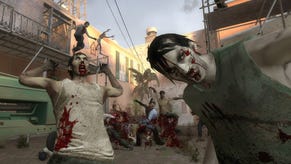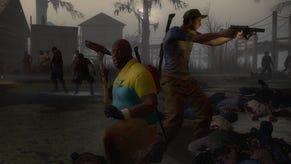Left 4 Dead 2 demo performance analysis
Digital Foundry tests the end of the world.
Alongside the new Assassin's Creed and Modern Warfare sequels, Valve's Left 4 Dead 2 must surely rank as one of the most highly anticipated games of the year for Xbox 360 users. Currently only available as a bonus to US customers who pre-ordered the game, we've managed to procure the Xbox 360 demo and subjected it to the usual battery of performance tests. This is the first time the Digital Foundry channel has seen the game running, and overall impressions are very positive indeed.
The demo itself is a decently-sized sampling of what is to come. Weighing in at a hefty 1.6GB, the download offers up two levels of The Parish to work through along with online and single-player gameplay. Similar to the first game, the CPU takes control of your three companions in the absence of any human companions. You get to sample a range of firearms, incendiaries like Molotov cocktails and pipebombs, plus the much-vaunted melee weapons. Realistically there's between 20 to 30 minutes play-time, which we've edited down a bit for this six minutes of frame-rate analysis.
From a technical perspective, frame-rate is essentially fairly solid (30FPS with a few caveats), and, similar to previous games running on the Source engine, we're looking at a v-synced 720p with no anti-aliasing. To smooth off edges a touch, a subtle blur filter has been added. These post-processing effects rarely look that great but here it works in concert with a well-implemented camera motion blur and isn't so distracting. On the plus side, texture filtering is a decent combination of trilinear with a good level of anisotropic filtering.
Where performance is impacted, it looks as though it's down to fill-rate. The biggest dips in the frame-rate graph are where many transparency effects are in play. While the Source engine's setup is seemingly designed for maximum fill-rate, the use of smoke and fog needs to be deployed carefully - geometry that clips through the transparency essentially ruins the effect of it, so the engine continually runs checks to make sure it never happens.
It also looks as though some alpha effects are generated at lower resolutions before being scaled up, most noticeable on the fulsome flame effects seen in the demo (and captured in the video thumbnail above). It's a common technique most often deployed in PS3 titles where GPU bandwidth is at a premium, but it's a good trick that can be used on any platform and it's rare that the user picks up on it.
Overall then, few surprises here: the Source engine on 360 looks to be more than up to the task of powering the sequel. If you fancy a bit of additional information on how Valve transitioned from PC to cross-format development, this GDC 2008 presentation is absolutely fascinating, and worth a look not just for the valuable info, but also for its strategic use of oddly appropriate comedy photography.









